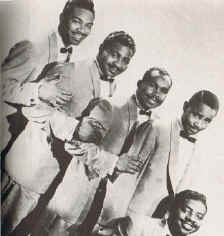 The Clovers started as a trio of Armstrong High School students in 1946 all from the same neighborhood in Washington, D.C. The leader of the group Harold "Hal" Lucas, sang baritone. From 1946 through 1949 the group went through many personal changes as they performed in several of the area's small nightclubs. In 1950, they were heard by Lou Kreftz, a local music dealer, while performing at the Rose Club. He got them a recording contract with Rainbow Records, a small New York label, but only one record was released in 1950. In February 1951 they signed with Atlantic Records, where they stayed for seven years. Their first Atlantic release was "Don't You Know That I Love You So," which sold a quarter million copies.The follow up, "Fool, Fool, Fool" did even better selling a half million copies and "One Mint Julip" almost went gold. Of their first nine records at Atlantic, three were number one rhythm and blues hits, three reached number two and two went to number three.
The Clovers started as a trio of Armstrong High School students in 1946 all from the same neighborhood in Washington, D.C. The leader of the group Harold "Hal" Lucas, sang baritone. From 1946 through 1949 the group went through many personal changes as they performed in several of the area's small nightclubs. In 1950, they were heard by Lou Kreftz, a local music dealer, while performing at the Rose Club. He got them a recording contract with Rainbow Records, a small New York label, but only one record was released in 1950. In February 1951 they signed with Atlantic Records, where they stayed for seven years. Their first Atlantic release was "Don't You Know That I Love You So," which sold a quarter million copies.The follow up, "Fool, Fool, Fool" did even better selling a half million copies and "One Mint Julip" almost went gold. Of their first nine records at Atlantic, three were number one rhythm and blues hits, three reached number two and two went to number three.In 1952 the group consisted of John "Buddy" Bailey (first tenor), Mathew McQuarter (2nd tenor), Harold Jerome Winley (bass), and Bill Harris (guitar). In September 1952 Bailey was drafted, and was replaced first by John Phillip and then Charlie White, who had been an original member of the Dominoes and the Checkers. In 1953 Billy Mitchell, who had been a solo artist at Atlantic, became the lead tenor. When Bailey returned from Korea in May, 1954 he alternated with Mitchell and the group expanded to six members.
Their peak year was 1952 with five songs in the national rhythm and blues top ten, but had hits for Atlantic until 1957. Their last hit was "Love Potion #9" for United Artist in 1959. By the early 1960s the group had disbanded with two new groups of Clovers, one led by Bailey and one led by Lucas, touring the country. The Lucas group continued to perform in clubs into the 1970s.
The Clover's sound was heavy on the bottom. Both the vocal group and and the instrumental backing employed an accentuated bass line. No distinctive lead tenor carried the group; rather, it was a blending of all the voices over a varied mixture of drums, saxophone, and piano that gave the recordings by the group the warm feel of warmth even on the up-tempo numbers.
Few rhythm and blues groups in this period could claim the popularity and longevity of the Clovers. While the Dominoes and the Orioles opted for the "better" clubs and hotels, the Clovers stayed within the Black community, becoming "their" vocal group more than any other at this time.
No comments:
Post a Comment